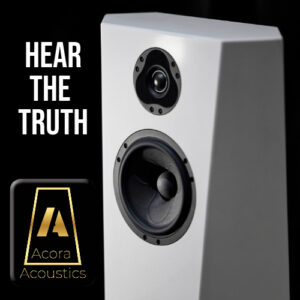What does it take for a two-way speaker to reach the heights of the world’s finest? The YG Acoustics Carmel 3 could be the answer.
Let me start by getting one thing straight: I’m not here for anything less than the best. As the ultra high-end reviewer here at INDULGR, my goal is to find the absolute best gear irrespective of price. I’m here for the crème de la crème. I’m always looking for the next thing to surpass my own standards. Anything less isn’t worth my time, and really, is it worth yours? Unless what I’m listening to just doesn’t live up to its price, that just isn’t a factor.
Words and Photos by Jameson Mourafetis
Sure $30k may sound extravagant for a small two-way tower, but the Carmels’ extraordinary performance never brings up the question of price.
The YG Acoustics Rebirth
If you’re new to YG Acoustics, they have been in the game since 2002, carving out a space in high-end audio. While they’ve always had serious engineering chops to back up their reputation, now under new ownership, the brand feels refreshed – bringing together loads of experience and ideas to the world of endgame loudspeakers.
Many of the last generation YG Acoustics speakers weren’t the easiest speakers to extract impressive sound from at shows–be it their finickiness with placement and room interaction or their difficult-to-find electronic synergy.
With their latest generation reference series, however, YG has moved beyond the gradual enhancements that many expect in audio, and while I’ve always been a fan of the Carmel speaker from YG Acoustics in particular, including the Carmel 3’s predecessor, the Carmel 2, Carmel 3 transcends all my expectations. The new YG Acoustics sound isn’t just evolutionary—it’s revolutionary. For such compact reference speakers, the Carmel 3s are making big waves. The third generation reference series is more than a few steps in the right direction. But I’m getting ahead of myself.

YG Acoustics Carmel 3
The YG Acoustics Carmel 3 is more than just a sealed (acoustic suspension) 2-way speaker. To say the very least, the level of engineering that has gone into these speakers puts them in rarified air in the audio industry.
- The cabinet is made from carefully designed machined aluminum panels and bracing
- The tweeter uses a new generation of YG’s hallmark hybrid soft-hard lattice braced technology
- The mid-woofer cone is machined from a single billet of aluminum.
The Carmel 3’s proportions and aesthetics make it a perfect fit for the high-end home. The aerospace-grade aluminum cabinets not only look stunning but also deliver an impressive stage scale for such a compact speaker. The enclosure is built from precision-machined aluminum alloy, up to 35mm thick where needed for added stability. This sealed design, combined with strategic internal bracing and damping, works wonders to reduce cabinet resonances. The design approach again being holistically multi-domain, delivers state of the art performance in an impressively svelte form. As far as I’m concerned, in the world of high end audio, Carmels are a design icon.
For more in-depth information about YG Acoustics specific technologies: https://www.yg-acoustics.com/technologies/
YG Acoustics offers the Carmels in two standard finishes, black and silver, but a wide variety of custom anodized color options are also available. I am partial to their custom dark bronze.
What’s in the box?
While they may look more or less the same as Carmel 2 (link) on the outside, the internals are far from the same. The all new third generation Ultra-coherent crossover is designed using an iterative cycle of listening, measuring, and multi-dimensional modeling. YG Acoustics doesn’t use the typical single-domain finite element analysis typical to high-end speaker design. They take a more holistic multi-domain modeling approach while designing every part of the speaker–from the drivers to baffle shape to the waveguide to the crossovers–that optimizes for phase linearity, low distortion, and excellent transient response through the crossover range and beyond across a range of over 200 different simulated amplifiers.
This approach is computationally heavy, but gives astounding results. The new Carmel 3 presents a level of coherence between each of the state of the art, ultra low distortion drivers rarely found at any price. Something that frankly isn’t complained about enough in high end audio is how easy it is in many designs to discern where the midrange transitions to the tweeter especially when outside of the often narrow listening sweet spot. This is a region often fraught with issues in all but the very best designs. You can identify no such point while listening to the Carmel 3s even well off-axis, and that’s an exceedingly rare feat. It presents as close to a point source as I’ve heard despite the traditional tweeter-midrange arrangement.

Back to My Expectations
I’m a huge fan of ultra-high-end two-way designs, and I know they can deliver some of the most transparent, coherent performances in the audiophile world — but they do tend to have some compromises, and so with the Carmels featuring a small, sealed, highly damped aluminum cabinet design, I knew what to expect, or thought I did.
The Carmel 3 present a sensitivity of 87dB/W/m, I assumed they’d need a serious amplifier to reach their peak performance. While this is more or less true, and while they do scale well with serious current delivery, their use of amplifier simulations during the design process has really paid off, and I was surprised to find that even amplifiers with modest power delivery could deliver pleasant results. Surprises aren’t something I encounter much in the audiophile world anymore, and pleasant surprises even more rarely, but the Carmels managed to do so in more ways than one.
Electronics Pairings
So what electronics pairings did I land on to extract the most from the Carmels?
The first was the Soulnote A-3 integrated amplifier, delivering 120W into 4 ohms or 60W into 8 ohms—a match I never expected to work. I’ve covered exactly what the Soulnote can do in greater depth in my full review of the A-3 here, but let’s just say that, despite its modest power figures, it produced an engaging and distinct sound with the Carmels that I absolutely loved hearing, and recommend wholly.
The second setup was with the Carmels driven by the Karan Acoustics POWERb stereo amplifier, rated at 800W into 4 ohms or 450W into 8 ohms. While I thoroughly enjoyed the YG-Soulnote pairing, the YG-Karan combo showcased what the Carmels are capable of when given even higher-end electronics. Albeit not the most logical pairing when considering price, but I like overkill.
The 220 lb Karan amplifier brought out significantly more and better quality low-end and dynamics than you’d ever expect to hear from such a small sealed 2-way tower, even at very low listening levels; something I look for in every high end system, and something most fail to deliver. This setup surprisingly also opened up more in every dimension spatially despite being a slightly darker sounding pre and amp pairing than the Soulnote integrated.
I won’t spoil any more details on the Karan experience, as that’s for an upcoming review, but it’s clear the Carmels can scale impressively as you pair them with higher-end electronics.
As any speaker reviewer should, I did try the Carmels with a variety of electronics, and they didn’t exhibit the finickiness with electronics pairings older YG Acoustics generations often did. No high-end pairing disappointed, but the aforementioned two systems were my favorites.
Sonic Choices / Scale
I get it, just about every speaker review claims an “expansive soundstage.” But what Carmels do despite their diminutive size is genuinely unique and is nothing short of amazing. Like many small speakers, they manage the disappearing act very well, but unlike many small speakers, in medium and far-field setups, the scale and depth makes you question if you’re still listening to a ‘small’ speaker: not with exaggeration, but with natural, truer to life stage reproduction, and importantly, without the miniaturization effect that’s far too common in smaller speakers even in the high end tier. Even in nearfield, the Carmels manage to scale in a way that feels natural, and yes, again, uncharacteristic of their size. Imaging is solid and lifelike, with depth, height, and stability that brings each musical element to life.

Tonal Character
YG also has made bold choices with the Carmel 3 and with their latest generation of reference speakers, opting for a slightly colored sound over strict neutrality—and I’m glad they did. The result is a pleasing tonal character that avoids pigeonholing itself into serving only certain genres of music or just boring audiophile recordings.
The bass is tight and punchy, an effect only achievable to this degree with a sealed design, while the low-end quality and resolution exceeds what I’d expect from a two-way speaker. The midrange has a sweet, engaging, immersive warmth. The top end is smooth and airy without sacrificing detail. They aren’t dark or rolled off, but there’s a slight softness and refinement in the highs that are hard to find at any price.
Despite this subtle coloration, transparency remains exceptional across the frequency spectrum, and as I mentioned earlier, coherence across the spectrum is off the charts.
The Carmels bring out the best in even less-than-ideal recordings without sacrificing resolution. Feed them more audiophile-friendly, high resolution content and you’ll find that their resolution is up there with the very best options available. You hear deep into everything you play on these speakers, but it’s never unpleasant, never boring, and above all, never harsh. I’d go as far as to say that anyone who struggles with the hardness and ruthless extension you find in the top end of many of today’s best modern speakers should look no further.
While I wouldn’t pair them with overly dark electronics unless you’re sensitive to treble, this character opens up a range of pairing options, including many excellent electronics that might seem too bright with other high-end speakers.
That isn’t to say they don’t need to be paired with top-tier electronics – they certainly deserve to be and scale extremely well when you do so. But it is to say that you won’t run into that issue in the treble that does prevent many electronics pairings with many speakers in this price tier, and you’ll truly almost never run into a pairing that’s harsh or sibilant.
Its tasteful, subtle coloration is a unique feature in this product tier. While setup remains crucial for optimal performance, like with any speaker at this level of performance,, the design’s versatility makes it suitable for more setups and electronic pairings than most high-end speakers. These are easy to recommend, and that extends to the entire YG Acoustics reference range.

Conclusion
(the long version)
If it hasn’t already been made clear enough, I’ve always been drawn to high-end two-ways. While excellent coherence is difficult to pull of in any speaker design, as I mentioned earlier in the review, well-executed two-ways are tough to beat in terms of transparency and coherence when compared to 3 and 4 way speakers with far more crossover components in the signal path and more drivers to worry about, but the Carmel 3s manage to do something special in this category. While I’m filled with trepidation to say this and at great risk of offending one of my absolute favorite speaker designers, I have to be honest about something…
These speakers eclipse my very long-standing favorite two-way, the Magico S1MK2 (link), as my new absolute favorites in this category, and unless I opt for one of their even higher-end pairs of reference towers, such as the new XX, I will be purchasing a pair of the Carmel 3s.
Trust your ears. You won’t be disappointed.
And at the risk of ruffling even more feathers than I already have, before the change in ownership, I frankly didn’t consider them to live in the same echelon/tier as my absolute favorite designers, and now I absolutely do consider them to be among the best. The YG Acoustics reference series has gone from being finicky with potential–in previous generations–to being always excellent–with the latest generation. They feel like a completely different thing, and they’re absolutely at the very least in the same conversation as other top-tier speakers available today. I’m thrilled to learn that the new owners really do seem to know what they’re doing. For those who’ve written off YG Acoustics in the past, you owe it to yourself to go listen to the new-gen reference speakers ASAP.
The new YG Acoustics sound isn’t just evolutionary, it’s revolutionary. For such compact reference speakers, the Carmel 3s are deservedly making big waves—and not just in audiophile circles. These are truly icons in the world of high end audio, and they’re a perfect fit for anyone who can appreciate state of the art sound and design.

So should you try them? I think you already know my answer. If ultra high performance, state of the art, world-class products are your language, then Carmel 3s fit right in.
And if you’re someone who appreciates a touch of warmth and tonal character over strict neutrality, then these are a perfect match. It suits listeners who want flexibility across genres without being limited to audiophile recordings.Even if you think you prefer a strictly neutral sound, you owe it to yourself to go listen to the Carmel 3s, and I can’t emphasize enough that if you’ve heard previous generations of YG Acoustics speakers and written them off, you’re doing yourself a disservice if you don’t go and find out for yourself what the new YG Acoustics’ sound is all about. Listen to them. Again, trust your ears. And I have no doubt you’ll come to the same conclusions I did.
Specs & Features
https://www.yg-acoustics.com/products/carmel-3/
About the author and INDULGR
As he alluded to above, Jameson, the owner and publisher here at INDULGR, is the resident high-end snob. He’s very up-front about his disdain for anything but the best. He has no time for gear with endgame prices without matching endgame performances, and anything less than a brand’s flagship series shouldn’t even be mentioned in his presence. And yes, unlike reviewers at other magazines, he can afford, and will purchase, the absolute best gear irrespective of cost. His goal is to find the summit in the world of audio and to share it with the rest of the luxury world that doesn’t know they need it yet. To that end, he’s in the process of building the flagship INDULGR listening room that will make clear INDULGR’s level of seriousness in the world of high-end audio as well as other luxury segments we cover.
This is where the absolute best gear in the world will be tested. It’s rarified air to have a space suitable for such gear, and even rarer for a magazine to have the expertise to execute it to this level. Flagship gear will be heard in a way never before listened to by review magazines. The big fish in the small pond of audio shouldn’t be worried though, INDULGR is playing in a much larger arena, and we intend to test gear their rooms wouldn’t properly handle anyway. This is for the client looking for the absolute best without thinking twice about it. They won’t notice the money is missing. IE these are not the 90 year old audiophiles you’re writing to, so don’t sweat it. We’ll take it from here.


































